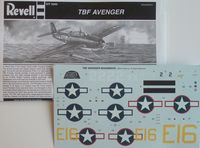Way back Then, I built several Aurora World War II “Famous Fighters”: Spitfire, FW-190, Messerschmitt Me-109, and Zero. In my innocent ignorance, I didn't realize there was anything better—until I got the Monogram SBD Dauntless as a Christmas gift.
Wow! What a difference! The Monogram model had a far more parts than the Aurora. There was an actual cockpit interior with separate crewmen, as opposed to Aurora’s flat top with the pilot molded integrally with the fuselage halves. The surfaces all had panel lines, tiny close-spaced riveting, and other fine details. Best of all: working features!
Once it was assembled, I flew the Dauntless on vital-but-dangerous dive-bombing missions: spin the prop, retract the landing gear, extend the dive brakes, raise and swivel the rear gunner’s machine gun to defend against Zeros, dive onto target… touch the latch under the fuselage, back of the wing. The big 500-pound bomb swings forward and down on its trapeze, clearing the prop… A hit! Right on target!
What then didn’t happen, back Then: my building the rest of Monogram’s ¼”-scale kits. I got sidetracked by the arrival at Thunderbird Drugs of the Airfix-72 constant-scale series. These could be gotten one per allowance week, at thirty-nine cents each. The Monograms were ninety-eight cents, two weekly allowances … or in the case of the P-38 Lightning, $1.49; THREE!
But I hadn’t forgotten them through all the intervening years of my “Dark Ages”. When I resumed our hobby a dozen years ago—in my wealthy maturity (!)—I planned to eventually build every one of those kits Monogram had back in the mid-60s, plus whatever new ones had been introduced since.
How fortuitous, therefore, that Internet Modeler editor Chris Banyai-Riepl handed me this kit. Revell and Monogram merged awhile back and kept all their old moldings. Re-releases in recent times have new boxings, with new box art and new decals. This is one such. I also had acquired an old boxing, and was able to do comparisons while doing the build for this review.
Everybody knows former President Bush (senior) was an Avenger pilot during the Second World War, and this re-release is specific for his airplane. The new box artwork and decal set make it so; no changes were made to the ancient plastic moldings.
These hold 58 pieces. Fifty-one make up the plane. There are four figures: pilot, turret gunner, running radioman, and Landing Signal Officer. With the latter’s freestanding screen and a pair of chocks, a mini-diorama can be arranged.
I read that Monogram’s engineers were instructed — from the earliest days — to put a lot of detail into as few parts as possible, so it wouldn’t be too hard for young modelers to build a good replica. The engine, for example, is molded in deep relief into the cowl. These moldings are an astonishing achievement for 1958, and still assemble well and look good.
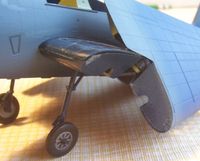 Seven of the moldings are ‘glass’: the greenhouse, turret top bowl, ventral observer’s station, and the four small windows low on the aft fuselage. Only two pieces make the cockpit: a continuous floor from the pilot’s cockpit through to the turret mount, plus a separate pilot’s head rest. The instrument panel is molded into the fuselage sides and is finished with a single decal.
Seven of the moldings are ‘glass’: the greenhouse, turret top bowl, ventral observer’s station, and the four small windows low on the aft fuselage. Only two pieces make the cockpit: a continuous floor from the pilot’s cockpit through to the turret mount, plus a separate pilot’s head rest. The instrument panel is molded into the fuselage sides and is finished with a single decal.
Eight tiny pieces still on these new moldings have no reference in the new instructions! They’re hinge parts to permit the wing outer panels to fold. The new instructions only say to glue the wing panels together. The old instructions have six additional illustrated steps…
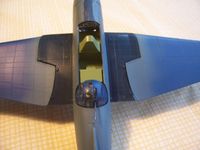 Out of nostalgic curiosity—could I have made wing folds work, way back Then?—I tried the old instructions, elaborate and exacting in those six steps. And I was able to make it all work… sort of!
Out of nostalgic curiosity—could I have made wing folds work, way back Then?—I tried the old instructions, elaborate and exacting in those six steps. And I was able to make it all work… sort of!
With everything properly aligned and assembled with super glue, to the best of my abilities Now, the wings can be carefully folded. But when extended, there are large gaps between the wing stubs and the outer panels, and the latter sag. There’s no way I could have made this work at all, back Then.
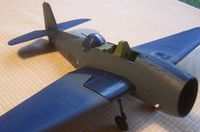 Ken Murphy claims he did! I never saw it, and the ravages of time, heavily accelerated by his mother’s ruthless housekeeping efficiency, means he can’t Now put it on the table to prove his claim. So… do we believe him? Want to try the wing folding yourself? If you get this new boxing, the bits will all be there, and I’ll gladly provide a photocopy of the old instructions…
Ken Murphy claims he did! I never saw it, and the ravages of time, heavily accelerated by his mother’s ruthless housekeeping efficiency, means he can’t Now put it on the table to prove his claim. So… do we believe him? Want to try the wing folding yourself? If you get this new boxing, the bits will all be there, and I’ll gladly provide a photocopy of the old instructions…
Anyway, I finally gave up, broke out the little hinge pieces, and glued the panels together. Revell is right to steer builders away from trying the old folding bits. If you build this kit Now, you can discard the tiny odd parts that have no reference in the instructions… or save them as a memento of Monogram’s engineering efforts back Then.
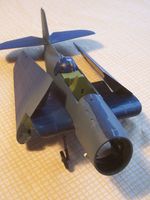 The rest of the build was fairly easy. There were only two other significant fit problems:
The rest of the build was fairly easy. There were only two other significant fit problems:
The ‘glass’ molding for the ventral observer gunner position is undersized. Unable to figure out how to neatly fill or shim it, but realizing that the molding had simple curvature, not compound, I made a replacement of thin transparent sheet plastic. Not easy, nor perfect, but it’s there.
The bomb bay doors sacrifice close fit for function. Gaps are left to accommodate the clever torpedo-dropping action mechanism. For static display, a few protrusions could be trimmed and the closed doors fitted and filled. But consider carefully before you sacrifice the ability to skim the model low over the living room floor, pull on a little stud, and drop a torpedo against the Musashi!
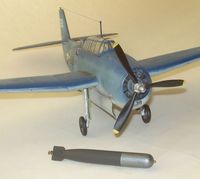 The other working features: the spin-able prop and the rear turret, which swivels and whose gun can be elevated, gave no trouble. Nor did the quite ingenious tailwheel/arrestor hook assembly. But the main gear members fit tightly into sockets as they’re assembled into the wing panels. They require subtle sculpting and sanding to reach a state where the legs hold position when out, but aren’t too difficult to retract. I confess to not devoting enough time and effort to do this right, and now it’s easy to break a main strut off its pivoting post.
The other working features: the spin-able prop and the rear turret, which swivels and whose gun can be elevated, gave no trouble. Nor did the quite ingenious tailwheel/arrestor hook assembly. But the main gear members fit tightly into sockets as they’re assembled into the wing panels. They require subtle sculpting and sanding to reach a state where the legs hold position when out, but aren’t too difficult to retract. I confess to not devoting enough time and effort to do this right, and now it’s easy to break a main strut off its pivoting post.
The markings seen on my build aren’t Bush’s, nor the alternate’s from the fine kit decal set. Using some of them — and they’re very good —supplemented by my decal stash, I did a scheme is based on photos and color profiles in Osprey Publications’ “TBF/TBM Avenger Units of World War 2”. I have an aversion to using any kit box’s decals, as they are. Partly this is because I never did anything else, way back Then, till the great day the mail included my first issue of “HisAirDec News”. I drooled over the included decal set, long before I heard the term “aftermarket”.
 The rest is dread at putting on a contest table, or even our club’s monthly Show-and-Tell area, a scheme exactly like somebody else’s. What if my version should look worse?
The rest is dread at putting on a contest table, or even our club’s monthly Show-and-Tell area, a scheme exactly like somebody else’s. What if my version should look worse?
The kit’s old instruction sheet promised that “Your Monogram model of the Avenger is a faithful miniature of the big plane, developed from plans, specifications and photographs supplied by the U.S. Navy and Grumman Aircraft Company.” I’m happy with how it turned out. It looks like the original as seen on Military Channel documentaries. I added a radioman to the crew actually on board, from my spares. The result IS an accurate miniature. It’s just not an Accurate Miniatures!
You worldly readers are perfectly aware of the existence of two other 1/48th scale Avengers. Lindberg Models has been resurrected, and they, too, have taken advantage of President Bush’s wartime piloting to re-issue their ancient kit. I’ve seen the new boxing, with its “Smiling George” portrait, but know nothing more about that kit, Then or Now.
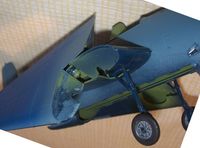 What I do have is Accurate Miniatures’ kit #3403, “Battle of the Atlantic”, with depth bombs, not a torpedo; one of a couple of slightly different boxings.
What I do have is Accurate Miniatures’ kit #3403, “Battle of the Atlantic”, with depth bombs, not a torpedo; one of a couple of slightly different boxings.
Revell’s re-issued kit is well-made, dimensionally close, and an admirable effort for its time. It’s still a fun and satisfying build. I recommend it as a nostalgic exercise, a break from a complex modern model, or an excuse to play with some young potential modeler who will enjoy the working features, just as I did when building the Dauntless so many decades ago.
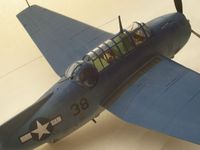 If you're serious modeler, you'll break the shrinkwrap on your Accurate Miniatures and get right to work on its 108 exquisitely detailed parts. Twenty-five are ‘glass’, including a gunsight. The engine’s separate and made of 3 components. Its engraving is subtle; little tiny parts make up much of its detailed duplication of the Avenger’s structure and fittings. And so on: it’s an order of magnitude better than the old kit, in every way.
If you're serious modeler, you'll break the shrinkwrap on your Accurate Miniatures and get right to work on its 108 exquisitely detailed parts. Twenty-five are ‘glass’, including a gunsight. The engine’s separate and made of 3 components. Its engraving is subtle; little tiny parts make up much of its detailed duplication of the Avenger’s structure and fittings. And so on: it’s an order of magnitude better than the old kit, in every way.
Except that its wing panels are molded together. You can’t fold them. Oh, wait! --You CAN fold them… all you need is to do is a lot of surgery with a bunch of elaborate and expensive resin and photoetched aftermarket parts. That’s how we do things now, eagerly succumbing to AMS. We’ve come a long way from 1958, huh?
My thanks to Internet Modeler and Revell for this review sample kit.
